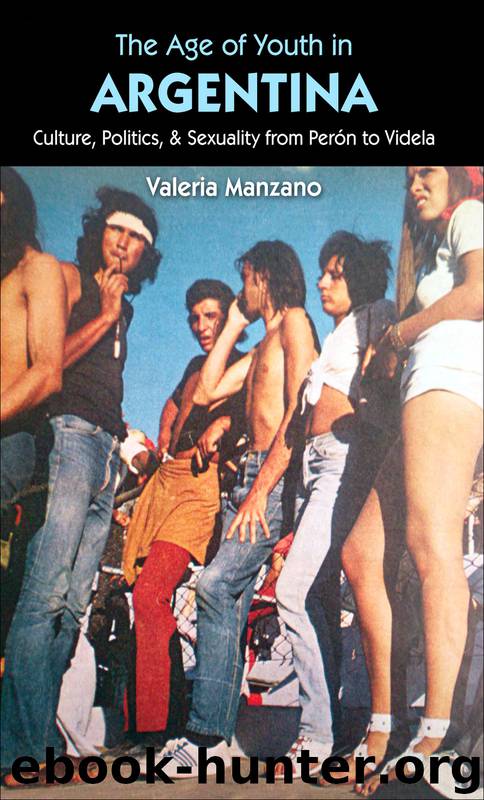Age of Youth in Argentina by Manzano Valeria;

Author:Manzano, Valeria;
Language: eng
Format: epub
Publisher: The University of North Carolina Press
Published: 2014-03-20T16:00:00+00:00
Feeling a Third World Argentina
In a new introduction to his Sociology of Modernization (1971), Gino Germani challenged those who identified Argentina with the Third World. He argued that, in contrast to countries in Asia and Africa—his shorthand for the Third World—Argentina was “a ‘middle-class’ nation at an international scale of development and modernization.” Forgetting this distinction, Germani cautioned his readers, “is a cause of political and ideological mistakes.”34 Founder of the so-called scientific sociology in the 1950s, Germani also popularized some of the most significant concepts through which many citizens of that “middle-class nation” grasped the sociocultural transformations that they lived through, such as “modernization.” By 1970, Germani might have felt satisfied: signs of modernization seemed to flourish in Argentina’s enduring urbanization (65 percent of the country’s population lived in cities), improving literacy rates (which reached 82 percent), and ongoing expansion of enrollment in secondary schools and universities.35 Situating Argentina within the prevailing paradigms of the Third World required effort. How and why, then, were educated youth—those who apparently benefited the most from belonging to a “middle-class” nation—so willing to identify their country as part of the Third World?
The political socialization of young people in the late 1960s and early 1970s Argentina occurred within and was shaped by a renewed political culture in which the assimilation of Argentina to the Third World constituted a key component. Scholars have tended to explain the rise of a “New Left” throughout the 1960s in terms of both the growing acceptance of armed struggle as a means for achieving national and social liberation as well as the ways in which left-wing intellectuals and militants reevaluated the Peronist movement as a potential road to Socialism.36 Although these novelties were indeed crucial, often overlooked—and perhaps naturalized—the Third World framework created commonality among politically and ideologically divergent groups, who attributed to the concept two basic meanings. First, the Third World was defined as a political geography highlighting the importance of decolonization of Asia and Africa and the need for similar transformations in “neocolonial” Latin America, which was depicted as economically and military dependent on the “imperialist centers” but, thanks to the success of the Cuban revolutionary process, ever more conscious of the opportunities of liberation. Second, the local uses of the Third World concept stressed the scope and intensity of social oppression, which required the systemic use of violence that usually came in the form of military rule. Along both lines Argentina would belong to that geography.37 A lexicon dominated by keywords such as dependency, systemic violence, and social oppression spread to Catholic, Peronist, and Marxist groups and pointed to the pervasiveness of the Third World framework in that New Left. The embrace of that approach also entailed connecting the local New Left with its counterparts in France or Italy, who were opening up their agendas to address anti-imperialism in displays of solidarity with the peoples in Asia, Africa, and Latin America—as demonstrated in the pantheon of heroes that presided over the rallies in 1968.38 The Argentine
Download
This site does not store any files on its server. We only index and link to content provided by other sites. Please contact the content providers to delete copyright contents if any and email us, we'll remove relevant links or contents immediately.
| Arms Control | Diplomacy |
| Security | Trades & Tariffs |
| Treaties | African |
| Asian | Australian & Oceanian |
| Canadian | Caribbean & Latin American |
| European | Middle Eastern |
| Russian & Former Soviet Union |
The Secret History by Donna Tartt(18163)
The Social Justice Warrior Handbook by Lisa De Pasquale(11954)
Thirteen Reasons Why by Jay Asher(8452)
This Is How You Lose Her by Junot Diaz(6440)
Weapons of Math Destruction by Cathy O'Neil(5832)
Zero to One by Peter Thiel(5494)
Beartown by Fredrik Backman(5357)
The Myth of the Strong Leader by Archie Brown(5239)
The Fire Next Time by James Baldwin(5017)
How Democracies Die by Steven Levitsky & Daniel Ziblatt(4958)
Promise Me, Dad by Joe Biden(4908)
Stone's Rules by Roger Stone(4859)
100 Deadly Skills by Clint Emerson(4691)
A Higher Loyalty: Truth, Lies, and Leadership by James Comey(4552)
Rise and Kill First by Ronen Bergman(4545)
Secrecy World by Jake Bernstein(4389)
The David Icke Guide to the Global Conspiracy (and how to end it) by David Icke(4381)
The Farm by Tom Rob Smith(4324)
The Doomsday Machine by Daniel Ellsberg(4246)
